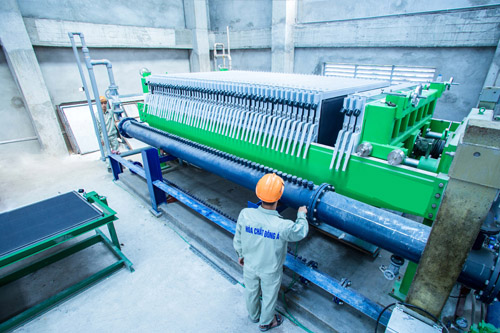Chlorine - Alkali (NaOH) is produced in Vietnam by Dong A Chemical. The business uses ion exchange membrane electrolysis, which is a cutting-edge technique used in developed nations.
Industry that produces chlorine-alkali (NaOH)
By electrolyzing salt solution, mostly utilizing sodium chloride (NaCl) as a raw material, the chlorine-alkali business creates chlorine (Cl2), alkali (alkaline soda or sodium hydroxide -NaOH), and potassium hydroxide (KOH). Potassium hydroxide is produced using either raw potassium or potassium chloride (KCl). A significant user of electrical energy is the chlor-alkali process.
The three basic electrolysis methods—mercury, diaphragm, and membrane—are used to produce chlorine and alkali. Chlorine gas, which has been saturated with water vapor, exits the electrolytic cell during the chlorination process at a temperature of 80 to 90 oC. Moreover, it has contaminants such salt vapors, nitrogen, hydrogen, oxygen, carbon dioxide, and traces of chlorinated hydrocarbons. The chlorine is sent to the drying towers for drying with concentrated sulfuric acid after being directly or indirectly cooled and having impurities removed. The gas is subsequently compressed and liquefied at various pressures and temperatures. Bulk tanks are used to store liquefied chlorine at room temperature or below.

Post-electrolysis technologies and goods
Compared to the two earlier technologies, the membrane cell process offers an environmental benefit. An impermeable ion-conducting membrane divides the anode and cathode. The female solution moves past the anode compartment, where chlorine gas is created by the oxidation of chloride ions. With 1,128 tons of alkaline soda generated by electrolysis for every ton of chlorine, the yield of alkaline soda is precisely proportionate to that of chlorine. Alkaline soda solutions have extremely low salt concentrations because of chloride migration, which occurs on cell membranes. The anode chambers release the depleted water, which is then re-salted.
Metal is employed as the anode while stainless steel or nickel is used as the cathode material in the cell membrane. In order to improve the surface area and decrease the excess voltage, the cathode is frequently coated with a catalyst. Ni-S, Ni-Al, and Ni-NiO blends, as well as combinations of nickel and platinum group metals, are examples of coating materials. In the chlor-alkali business, perfluorinated polymers are often utilized to create the membranes. Typically, chlorine is created close to the site of ingestion. Chlorine must be handled carefully and transported using best methods to reduce any potential risks. Transport of chlorine takes place through pipeline, road, and rail.
Water electrolysis produces hydrogen as a byproduct (28 kg per ton of chlorine), which is frequently utilized locally as a combustible material, transferred to other businesses as a fuel, or marketed and shipped. behave chemically. Due to its great purity, it may be employed at integrated sites for a variety of processes, such as the production of ammonia, methanol, hydrochloric acid, hydrogen peroxide, etc.
The processing processes unsalting and storage, seawater/brine filtering and re-saturation, chlorine processing, soda alkalinity, and hydrogen are among those that are similar to all methods in addition to cell electrolysis.
The primary system for mercury and diaphragm technologies is used in the female water purification process, and a secondary system for membrane technology is used. These procedures are required to get rid of contaminants (sulphate anions, calcium, magnesium, barium, and metal cations) that could interfere with the electrolysis process.
In the process of primary water purification, calcium and magnesium ions such as calcium carbonate (CaCO3) and magnesium hydroxide (MgOH) are precipitated using sodium carbonate and sodium hydroxide (OH) Moreover, during this process, metals might precipitate as hydroxides. The removal of sulfate anions by precipitation of calcium sulfate (CaSO4) or barisul fat can be used to reduce the level of sodium sulfate. Nevertheless, both methods can be hazardous due to their toxicity. (BaSO4) Impurities are eliminated following precipitation by sedimentation, filtration, or a combination of the two processes. Leaching and ultrafiltration are two further strategies for removing sulfate.
In order to adequately eliminate suspended matter and safeguard the ion exchange resins from harm, secondary water purification includes a polishing filter stage and softening of the tap water in an ion exchange unit. Alkaline earth metals can be reduced to extremely low concentrations using the ion exchange chelate resin process. High quality hydrochloric acid and sodium hydroxide solution are used to periodically rejuvenate this resin. In a reaction with the chlorine gas in the column, the hydrogen is eliminated rather than diluting the gas that is left over after part of the chlorine condenses. This process generates hydrogen chloride gas, which may be recovered in a hydrogen chloride HCL plant.